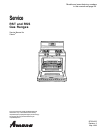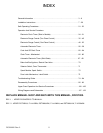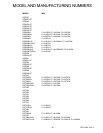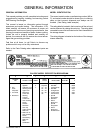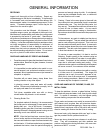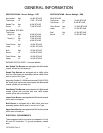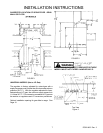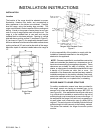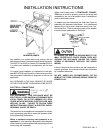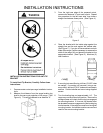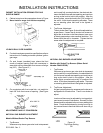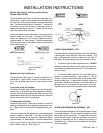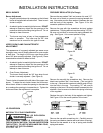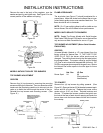GENERAL INFORMATION
5 RC231002 Rev. 3
soon as cool enough using dry cloth. If not cleaned,
there may be noticeable smoke, odor, or visible dirt
the next time the unit is used.
3. Crazing - Craze is the name given to the small hair
line marks which are sometimes found in enameled
surfaces after use. They look like little cracks, but
they are not. The enamel around them will never chip
or peel off due to these marks. As we cannot
guarantee enamel against crazing or discoloration,
the customer should be informed as to the proper care
of enamel.
To the customer, any mark is a defect, as they do not
understand enamel. They are afraid the enamel will
peel or crack off leaving a rusty spot. This is not true
as craze marks will never peel or crack. A craze mark
is simply a place where the outer coat of enamel has
separated. The dark color that appears in the crack
is dust that catches in the opening.
To service a craze complaint, it is best to use the
following: Explain crazing to the customer using as
an illustration the effect of hot water in a cold glass -
it cracks. Compare it to the hairlines in dishes and
cups due to continued heating and cooling. If the
customer can be made to understand that the enamel
will never come off, the customer will be satisfied.
One point to remember with service calls on crazing
is to take care of it immediately. The longer the
customer has to wait, the worse it appears to her.
While this is true of all service work, it is especially
true of crazing complaints. Make it a point to go out
the same day the complaint is received.
CARE AND HANDLING OF CHROME, GLASS, OR
METAL FINISH
To keep the stainless, chrome, or glass finishes "looking
new" wash with soap and water, rinse, then dry with a clean
cloth. If a polish is necessary, only the highest quality
chrome cleaning compounds are recommended.
Finger marks and smears may easily be removed with a
mild cleaner such as glass wax and simonize cleaner.
Such agents should be used sparingly. Never use ordinary
steel wool as it may leave a film of iron which will rust and
discolor creating the illusion that the finish is rusting.
Never use harsh, gritty cleaners which can "age" or dam-
age the porcelain and/or polished metal trim.
Never use strong chemical oven cleaners in a self-clean
oven. They are unnecessary and their residues can
produce noxious odors during self-clean, with oven tem-
peratures of 900°F. or more.
RECEIVING
Inspect unit thoroughly at time of delivery. Report any
visible damage to the carrier immediately. If the damage
is "concealed" and not discovered until after delivery has
been accepted, make a "concealed damage report" to the
carrier. "Concealed damage report" forms may be ob-
tained from the carrier's agent.
This procedure must be followed: All shipments, i.e.,
complete range or parts, are shipped at the buyer's risk.
Manufacturer's responsibility ends when the consignment
is accepted by the carrier in "good order". Manufacturer
will give every assistance on damage claims by supplying
any necessary supporting papers, such as invoices or bills
of lading. It must be understood that this assistance does
not imply acceptance of responsibility for settlement of
such claims. Claims for loss or damage cannot be de-
ducted from the invoice or payment of the invoice cannot
be withheld pending adjustment of claims. Do not return
any unit or parts for credit without written consent.
CARE AND HANDLING OF PORCELAIN ENAMEL
1. Porcelain enamel is glass that has been fused onto a
metal surface. Because it is glass, however, it cannot
be guaranteed.
It is impossible to make perfect color match in com-
mercial enamel, and occasional variations must be
expected. Minor imperfections are not just causes for
complaint or rejection.
Porcelain will not stand heavy, sharp blows from
cooking utensils or any other object.
In cleaning enamel, soap and water will usually
suffice. Remove any discoloration promptly, but do
not apply cold water to a hot surface.
Fruit juices, vegetable acids, sour milk, or strong
mineral acids may discolor or etch enamel.
2. Cleaning Broiler Pan
For simplest method of cleaning, it is recommended
that broiler pan be submerged in warm water imme-
diately after use. Use a stiff brush, if necessary.
Reheating broiler pan after it has been used without
cleaning will result in fats and greases burning on and
becoming much more difficult to remove.
NOTE: After the food has been removed from the
oven or broiler, and the unit has been turned off, leave
the oven and broiler door open for a few minutes to dry
out the interior. If food has cooked over or grease has
spattered the interior, clean the parts thoroughly as



